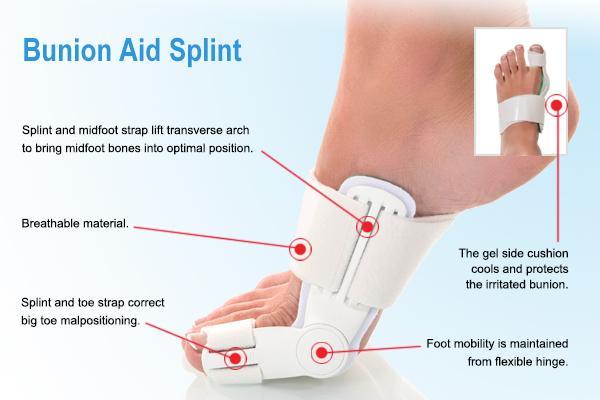1. How many Bunion Aid® splints are in the box?
|
There is one splint per box, which fits most sizes. |
2. How often should I wear the Bunion Aid®?
We recommend starting with 20 minutes a day then slowly increase to 2-3 hours a day and during the night. If you have discomfort reduce the tension of the straps.
Bunion Aid® is a day and night splint. One of the unique benefits of Bunion Aid® is the flexible hinge that enables you to correct the mal-alignment of the big toe while walking and while your foot moves at night during sleep.
Please note: Every foot is different and the results depend on several variables: severity of the angle, tightness of the surrounding tissues and compliance. However you should have pain relief right away and you should see your toes start to straighten in the first 6-8 weeks. (Avoid wearing narrow and restrictive shoes)
Compliance is critical. To sustain correction, we recommend wearing the splint 2-3 times per week, at night and/or a couple of hours during your daily activities. Also if you experience any pain, wear the Bunion Aid® for relief.
3. How does the Bunion Aid® differ from a rigid splint?
|
Only the Bunion Aid® splint has a flexible hinge that allows you to walk while correcting your big toe at the same time. The brace is placed along the inside of the foot and the straps are used to align the toe. It is important to have correct alignment of the big toe while standing. It is even more important to have correct alignment of the big toe while walking because the big toe affects your body’s gait – the movement of the knee, hip and pelvis. |
 |
4. Does the splint fit in a shoe?
It can but your foot must fit comfortably in the shoe so it has to have a wide toe box. We highly recommend wearing it barefoot or with a sock only around the house.
5. Should I use the splint if I have little or no pain?
Yes. Your bunion can worsen if not treated. If the big toe is not straightened the bunion can worsen, hammertoes can develop and the mechanics of the foot can deteriorate causing more stress on the knees, hips and pelvis joints.
6. What if I have pain after using the splint?
Usually this is caused by wearing the Bunion Aid® for too long or adjusting the toe strap too tightly at first. Start by wearing the splint for 20 minutes. If that’s comfortable increase the amount of time you wear it each day. Gradually work up to tightening the toe strap. Remember it takes time for the soft tissue around the joint to stretch.
7. What if the splint slips or swivels or rotates to the top of the foot?
You are most likely tightening the toe strap too much or not cinching the mid-foot strap enough. This can pull the brace over the top of the foot. See how to put on the splint here. If the splint continues to slip, the angle of your bunion might be too severe to wear the Bunion Aid®.
8. What if the toe strap is too long?
Trim the excess hook and loop with scissors.
9. Does Bunion Aid® work for severe bunions?
Bunion Aid® is recommended for mild to moderate bunions. If you can move your big toe into a more corrected position with minimal force, then it is more likely to respond to Bunion Aid®.
10. Will Bunion Aid® help with my hammertoe?
People with bunions often have hammertoes. Bunion Aid will relieve pressure and help the toes spread apart.
11. After my toe is realigned, how long do I need to keep wearing the splint?
Compliance is critical. To sustain correction, we recommend wearing the splint 2-3 times per week, at night and/or a couple of hours during your daily activities. Also if you experience any pain, wear the Bunion Aid® for relief.
12. Is the Bunion Aid® splint recommended by podiatrists?
The Bunion Aid® Treatment Splint is recommended by Podiatrists for effective treatment of mild to moderate bunions. Read what prominent podiatrists have to say about Bunion Aid® here.
13. What else can I do for my bunions?
- Exercise! Bunions are formed by hyper-mobility of the toe joint so strengthening muscles through a variety of activities (walking, hiking, skating, etc.) is important.
- Avoid high heels
- Avoid narrow and pointed toe shoes
- Avoid any shoes that don’t have support like flip-flops
14. Can Bunion Aid® be used after surgery?
The Bunion Aid® splint is a great treatment to use after surgery to the surgical correction of the big toe. Bunion Aid® provides correction, padding, arch support and stabilization. Its always a good idea to consult with your medical professional.
If Hallux varus (when the big toe goes too far outward) develops after surgery, it is important to splint quickly to help prevent further shifting of the big toe. Bunion Aid® Post Surgical Splint will hold the surgical fixation. Consult your medical professional.



